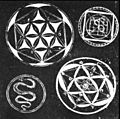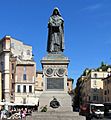Giordano Bruno facts for kids
Quick facts for kids
Giordano Bruno
|
|
|---|---|

Portrait from Opere di Giordano Bruno, published in 1830
|
|
| Born |
Filippo Bruno
January or February 1548 Nola, Kingdom of Naples
|
| Died | 17 February 1600 (aged 51–52) |
| Cause of death | Execution by burning at the stake |
| Era | Renaissance |
| School | Renaissance humanism Neopythagoreanism |
|
Main interests
|
Cosmology |
|
Notable ideas
|
Cosmic pluralism |
|
Influences
|
|
Giordano Bruno (born Filippo Bruno, January or February 1548 – 17 February 1600) was an Italian philosopher, poet, and thinker about the universe. He also studied esotericism, which involves secret knowledge.
Bruno believed that the stars were like our own Sun. He thought they had their own planets orbiting them. He also imagined that these planets might have life, a belief called cosmic pluralism.
He strongly felt that the universe was infinite and had no single center. Because his ideas went against the teachings of the Roman Catholic Church, he was accused of heresy. The Inquisition then had him burned at the stake.
After his death, Bruno became very famous. Many people in the 1800s and early 1900s saw him as a hero for science. Most historians now agree that his trial was more about his religious and afterlife beliefs than his ideas about the universe. Still, Bruno's case is important in the history of free thinking and the start of modern science.
Besides his ideas about the universe, Bruno also wrote a lot about the art of memory. This was a way to remember things using special techniques.
Contents
Life of Giordano Bruno
Giordano Bruno was born Filippo Bruno in Nola, Italy, in 1548. His father, Giovanni Bruno, was a soldier. As a young boy, he went to Naples for his education. He studied at a monastery and attended public lectures.
At 17, he joined the Dominican Order at a monastery in Naples. He took the name Giordano. He continued his studies and became a priest when he was 24. While in Naples, he became known for his amazing memory skills. He even traveled to Rome to show his memory system to Pope Pius V.
His talents caught the eye of King Henry III of France. Bruno later said that the King asked him if his memory was natural or magic. Bruno explained it was from organized knowledge. He then published a book on memory called The Shadows of Ideas, which he gave to the King. The King then gave him a special teaching job with a salary.
Bruno then went to France. There, he published several books about memory. These included De umbris idearum (On the Shadows of Ideas) and Ars memoriae (The Art of Memory). These books were based on his ideas for organizing knowledge. He also wrote a comedy play called Il Candelaio (The Torchbearer).
Bruno dedicated his books to powerful people like King Henry III. This shows he was becoming well-known and moving in important circles. However, his love for free thinking and reading forbidden books soon caused him trouble.
From 1583 to 1585, Bruno lived in England. During this time, he published some of his most important works. These included six "Italian Dialogues" about the universe. Some of these were La cena de le ceneri (The Ash Wednesday Supper) and De l'infinito, universo et mondi (On the Infinite, Universe and Worlds).
Bruno was allowed to teach at Wittenberg for two years. He lectured on Aristotle. But when the ideas there changed, he was no longer welcome. In 1588, he went to Prague. He received some money but no teaching job. He then taught briefly at Helmstedt. However, he had to leave again in 1590. This was because the Lutherans excommunicated him.
During this time, he wrote several books in Latin. These included De Magia (On Magic) and De Vinculis in Genere (A General Account of Bonding).
In 1591, Bruno was in Frankfurt. He received an invitation from Giovanni Mocenigo, a rich man from Venice. Mocenigo wanted to learn the art of memory. Bruno also heard about a teaching job in mathematics at the University of Padua. At this time, the Inquisition seemed less strict. Also, Venice was a very open state in Italy. Bruno made the big mistake of returning to Italy.
He first went to Padua. He taught there for a short time. He tried to get the mathematics job, but Galileo Galilei got it a year later. Bruno then accepted Mocenigo's invitation and moved to Venice in March 1592. For about two months, he taught Mocenigo. During this time, he shared some of his unusual ideas.
Mocenigo reported him to the Venetian Inquisition. Bruno was arrested on May 22, 1592. Many charges were brought against him. One main charge was his belief in the plurality of worlds. Bruno defended himself well. He said some of his ideas were philosophical and denied others. He also admitted he had doubts about some church teachings. However, the Roman Inquisition asked for him to be moved to Rome. After many months, Venice agreed. Bruno was sent to Rome in January 1593.
Imprisonment, Trial, and Execution
Bruno was held in prison for seven years during his trial in Rome. He was kept in the Tower of Nona. Some trial papers are lost, but others were found in 1940. The many charges against Bruno came from his books and witness statements. These charges included:
- Having ideas against the Catholic faith.
- Having ideas against the Trinity (God as Father, Son, and Holy Spirit).
- Having ideas against Jesus being divine and the Incarnation (God becoming human).
- Having ideas against the virginity of Mary.
- Having ideas against Transubstantiation (the bread and wine becoming the body and blood of Christ) and the Mass.
- Saying there were many worlds and that they were eternal.
- Believing in metempsychosis (souls moving to new bodies) and human souls moving into animals.
- Practicing magic and telling the future.
Bruno defended himself just like he did in Venice. He said he accepted the Church's main teachings. But he tried to keep his ideas about the universe. He strongly believed in the plurality of worlds, even when told to give up this idea. Cardinal Bellarmine oversaw his trial. He demanded that Bruno take back all his ideas. Bruno refused. On January 20, 1600, Pope Clement VIII declared Bruno a heretic. The Inquisition then sentenced him to death.
Bruno was burned at the stake as a heretic by the Inquisition in 1600. His ashes were thrown into the Tiber river.
All of Bruno's works were put on the Index Librorum Prohibitorum (a list of forbidden books) in 1603. Today, Bruno is a symbol for free thought and speech in Rome. An annual service is held near where he was executed.
Physical Appearance
The first known picture of Bruno is an engraving from 1715. It is thought to be based on a lost original portrait. This engraving has been used for later images of him.
Records from his imprisonment in Venice in 1592 describe him. He was "of average height, with a hazel-coloured beard and looked about forty years of age."
Giordano Bruno's Cosmology
In 1584, Bruno published two important philosophical books: La Cena de le Ceneri and De l'infinito universo et mondi. In these books, he shared ideas similar to those Galileo Galilei would later have about how motion works.
Bruno explained that everything on Earth moves with the Earth. He used an example of throwing something from a ship. If you throw a stone straight up from the mast of a moving ship, it will still land at the bottom of the mast. This is because the stone also moves with the ship. This idea was very advanced for his time.
Bruno believed his infinite universe was filled with a special substance. He called it "pure air," aether, or spiritus. This substance offered no resistance to the heavenly bodies. He thought these bodies moved on their own, not because they were fixed.
He wrote: "The universe is then one, infinite, immobile.... It is not capable of comprehension and therefore is endless and limitless, and to that extent infinite and indeterminable, and consequently immobile."
Bruno's ideas about the universe separated "suns" from "earths." Suns produce their own light and heat, and other bodies move around them. Earths move around suns and get light and heat from them. Bruno thought that many of the objects we call fixed stars are actually suns. According to scientist Steven Soter, Bruno was the first person to understand that "stars are other suns with their own planets."
Bruno also wrote that other worlds "have no less virtue nor a nature different from that of our Earth." He believed that, like Earth, they "contain animals and inhabitants."
In the late 1500s and throughout the 1600s, people often made fun of Bruno's ideas. But his ideas also sparked many debates and inspired others.
Giordano Bruno's Legacy
Giordano Bruno Foundation
The Giordano Bruno Foundation is a non-profit group in Germany. It supports "Evolutionary Humanism." Herbert Steffen started it in 2004. The foundation speaks out against religious fundamentalism and nationalism.
Giordano Bruno Memorial Award
The SETI League gives an award each year to honor Giordano Bruno. It goes to someone who has greatly helped the search for extraterrestrial intelligence (SETI). Sociologist Donald Tarter suggested the award in 1995. The trophy is called a Bruno.
Astronomical Objects Named After Bruno
A 22-kilometer wide impact crater on the far side of the Moon is named Giordano Bruno in his honor. Also, two Asteroids are named after him: 5148 Giordano and 13223 Cenaceneri. The second asteroid is named after his book La Cena de le Ceneri ("The Ash Wednesday Supper").
Other Remembrances
The radio station 2GB in Sydney, Australia, is named for Bruno. The letters "GB" in its name were chosen to honor him. People who followed Theosophy, who first owned the station, greatly admired Bruno.
Works
- De umbris idearum (On the Shadows of Ideas, 1582)
- Cantus circaeus (Circe's Song, 1582)
- Ars memoriae (The Art of Memory, 1582)
- Candelaio (The Torchbearer, 1582; a play)
- La cena de le ceneri (The Ash Wednesday Supper, 1584)
- De la causa, principio, et uno (Concerning Cause, Principle, and Unity, 1584)
- On the Infinite Universe and Worlds (On the Infinite, Universe and Worlds, 1584)
- Spaccio de la bestia trionfante (The Expulsion of the Triumphant Beast, 1584)
- De gli eroici furori (The Heroic Frenzies, 1585)
- De vinculis in genere (Of Bonds in General, 1591)
- De monade numero et figura (On the Monad, Number, and Figure, 1591)
- De imaginum, signorum et idearum compositione (On the Composition of Images, Signs and Ideas, 1591)
Images for kids
See also
 In Spanish: Giordano Bruno para niños
In Spanish: Giordano Bruno para niños
- Fermi paradox
- List of Roman Catholic scientist-clerics








